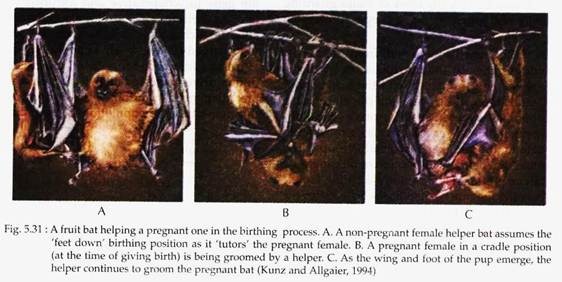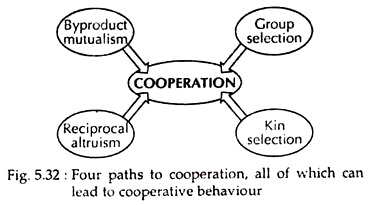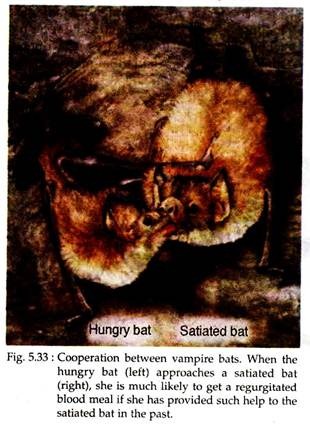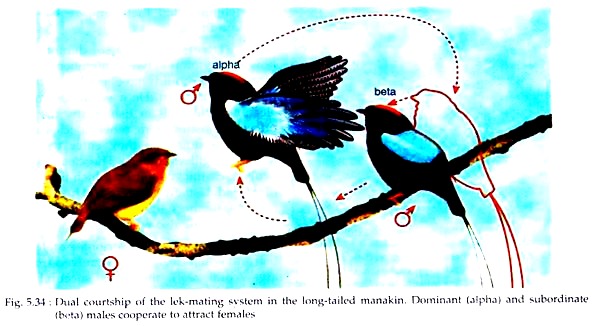In this article we will discuss about:- 1. Range of Cooperative Behaviours 2. Paths to the Evolution and Maintenance of Cooperation 3. Ecological Factors Involved in Cooperation.
Range of Cooperative Behaviours:
Cooperation occurs in many species in the animal kingdom and is manifested over a wide variety of behavioural context: foraging, predation, anti-predatory behaviour, mating, play, aggression, and so forth.
Some cooperative behaviours are discussed:
(a) Helping in the Birthing Process:
An interesting case of cooperation during the birthing process has been observed in the Rodriques fruit-bat (Pteropus rodricensis) by Kunz and Allgaier (1994). In these bats, non-pregnant females assist pregnant individual in the birthing process by licking the pregnant individual as well as wrapping their wings around expectant mothers (Fig. 5.31). The mothers-to-be bat don’t go into the typical feet down position until helpers took this position and ‘tutored’ them.
Such case of helping during birth has also been reported among marmosets (Callithrix jacchus), Indian elephants (Elephas maximus), African hunting dogs (Lycaon pictas), raccoon dogs (Nyctereutes procyonoides) and bottle-nose dolphins.
(b) Social Grooming:
Social grooming or allogrooming is a cooperative behaviour where one individual grooms another, which is most frequently observed by primatologists. Primates of many different species have often been found engaged in various forms of grooming behaviour.
Such behaviour may serve many functions simultaneously such as:
(i) Removal of ectoparasites;
ADVERTISEMENTS:
(ii) Tension reduction;
(iii) Coalition formation;
(iv) Reduced aggression from other individuals, particularly dominant group members;
(v) Access to scarce resources such as water or food;
ADVERTISEMENTS:
(vi) Entrance into new groups;
(vii) Aid in chasing potential predators away; and
(viii) Future association with individuals who have ‘special skills’ that others do not possess.
However, Maestripieri (1993) pointed out that grooming others has its disadvantages also. For example, adult female macaques involved in social grooming were found to be less vigilant with respect to the whereabouts of their offsprings, thereby subjecting the offspring to increased rates of aggression from other troop members.
(c) Group Hunting:
Group hunting has been observed in many animals such as Harris’s hawks (Parabuteo unicinctus).
The arrays of hunting tactics used are:
(i) ‘Surprise pounce’, involving several hawks coming from different directions and converging on a rabbit.
(ii) A ‘flush-and-ambush’ strategy, where the hawks surround and alertly watch the location where the rabbit disappears. One or two hawks try to penetrate the cover while one or more hawks pounce upon the prey and makes the kill.
(iii) ‘Relay attack’ which involves a constant chase of a rabbit for several minutes taken up alternately by party members.
(d) Nest Raiding:
ADVERTISEMENTS:
‘Gangs’ of females cooperate to overpower males in the context of nest guarding in three-spined stickle backs. In the case of this fish, parental care is undertaken by males alone. Females form large groups (of up to a few hundred), that raid and destroy the nests of males guarding eggs and often eating the eggs present in such nests.
The benefits obtained from such nest raiding are:
(i) The nutritional value of the eggs eaten;
(ii) Mating with the male whose nest has been destroyed,
(iii) Eliminating potential competitors for one’s own offspring.
However, the males are able to defend the nest against small groups. The males are helpless in the case of onslaught by larger groups. Here, mainly single female benefits the most — the one who initiates the raid and will ultimately mate with the male whose nest was destroyed.
(e) Allee Effect:
Allee (1951) pointed out the unfavourable consequences of under-crowding, referred to as Allee effect. Allee experimentally showed that the goldfish (Cyprinus sp.) reared in a toxic colloidal suspension of silver survived longer than they did alone.
This is due to the slime produced by the fish present in such conditioned waters, precipitating the silver on the bottom of the tank, thus protecting them. Another example is the planarian flatworm (Planaria sp.) which gain protection from ultraviolet rays by grouping.
Paths to the Evolution and Maintenance of Cooperation:
The study of cooperation has emerged over the last forty years. From the innovative work of W. D. Hamilton (1963) to the present, four paths have been developed which are responsible for the evolution and maintenance of cooperation in animals (Fig 5.32). These paths are kin-selected cooperation (dealt with later), reciprocity, by-product mutualism and group selection.
A. Reciprocal Altruism:
In 1971, Robert Trivers put forward the evolution of cooperation between unrelated individuals through his published paper “The Evolution of Reciprocal Altruism”. Individuals may cooperate and behave altruistically if there is a chance that they will be the recipients of such acts at a later time.
According to Trivers, the gene for cooperative and altruistic acts may be selected if individuals differently allocate such prosocial behaviours to those who already have been cooperative and altruistic (doing well for others) towards the donor.
Trivers showed that if altruistic acts are dispensed randomly to individuals throughout a large population, genes promoting such behaviour will disappear, because there is little likelihood that the recipient will pay back the altruist. However, when altruistic acts are dispensed non-randomly among non-relatives, genes promoting them could increase if some sort of reciprocation occurs.
The factors that are responsible for such likelihood are:
1. Length of lifetime, where long- lived organisms will have a greater chance of meeting again to reciprocate.
2. Dispersal rate, where low dispersal rate will increase the chance of occurrence of repeated interactions.
3. Mutual dependence, where clumping of individuals will increase the chances for reciprocation.
However, in any social system if cheating reaches a high enough level, altruistic acts would become infrequent.
The importance of reciprocal altruism can be stressed through the following field studies:
1. Olive baboons (Papio anubis) of Africa shows coalition between males, in which two unrelated males join forces against a third male. If that third male was in consort with a female in estrus, one of the attackers might gain access to her. The pair of males would maintain the previously established coalition, and the next ‘stolen’ female would be taken over by the other member of the male pair.
2. Wilkinson (1984, 1990) reported that a typical group of vampire bats (Desmodus rotundus) is composed largely of females with a low degree of relatedness. In a nest of vampire bats, females regurgitate blood meals (obtained from cattle and horses) to other bats that have failed to obtain food and would die of starvation if they do not receive a blood meal every sixty hours (Fig. 5.33).
Most of these exchanges were generally found between mother and offsprings. Wilkinson further concluded that both relatedness and association contributed significantly to the pattern of exchange.
For reciprocity to persist, Wilkinson suggested three lines of evidence:
(i) The pairs must persist long enough to permit reciprocation,
(ii) The benefit to the receiver must exceed the cost to the donor, and
(iii) Donors must recognise cheaters (those that do not reciprocate) and not feed them. Wilkinson also demonstrated that vampire bats meet these conditions.
3. Trivers (1971) also demonstrated how cooperation between members of different species could have evolved through reciprocal altruism. He used the example of cleaning symbiosis in fish. Many fish clean off ectoparasites from other species of fish (hosts).
In doing so they enter the host’s mouth or gill chambers. The cleaners have evolved distinct colour by which they can be identified. Usually cleaners and hosts meet at stations, the host signals when it is ready to be cleaned and also when it has had enough.
Ectoparasitism is a serious problem for fish and when cleaners are removed from the area (coral reef), the hosts succumb to a variety of diseases. If cleaners and hosts live a long time and hosts use the same cleaner repeatedly, reciprocal altruism is possible. The hosts that eat cleaners after having been cleaned by them may profit in the short run since they gain an easy meal, but would later be selected against as the supply of cleaners would be reduced.
B. By-product Mutualism:
By-product mutualism is another path to the evolution of cooperation. Here cooperation occurs when an individual pays an immediate cost or penalty for not acting cooperatively and the immediate net benefit outweighs that of cheating. A very good example can be cited in the case where two individuals are trapped in a cave and the only way out is for both to push the large boulder blocking the entrance.
Here, there is no temptation for either one not to do so, as both individuals would pay a large cost if either of them fails to cooperate. A prerequisite for by-product mutualism is the probability that a defector will be the victim of its own cheating.
By-product mutualism differs from reciprocal altruism in two fundamental ways:
1. There is no temptation to cheat in by-product mutualism, as the environment favours either everyone cooperating or no one cooperating. So there is no apparent cost to either individual in by-product mutualism, while in reciprocal altruism the costs to the actor seem to outweigh the benefits.
2. In most forms of reciprocal altruism some form of score keeping (tracking the partner’s behaviour over time) is required. On the other hand, no score keeping is required for cooperation via by-product mutualism. Thus, reciprocal altruism is similar to by-product mutualism except that a time delay is involved.
To support the above, a good example of by-product mutualism might be the resting flocks of quail that huddle in the cold weather. In this simple aggregation, there is no apparent cost to individuals and there is no time delay as both are immediately benefited through protection from freezing.
Some more examples of by-product mutualism are cited:
1. Two males of long-tailed manakins (Chiroxiphia linearis) in the forests of Costa Rica cooperate in a complex display (lekmating system) in order to attract a receptive female. The display comprises of a duet of the “Toledo” song and dual-male leapfrog hops and “butterfly” flights (Fig. 5.34). Dominant (alpha) males get almost all of the copulations, yet subordinate (beta) males do much of the work display (McDonald and Potts, 1994).
The most obvious question here is why subordinate (beta) males cooperate and give up reproduction? It is because that the beta males increase their direct fitness, but the payoff is delayed from five to thirteen years. Eventually beta males would ascend to alpha status. This cooperative behaviour cannot be considered as reciprocal altruism as the alpha male never pays back the effort expended by the beta male.
Therefore, here both alpha and beta males are benefited due to increase of their direct fitness, by cooperating to attract females. Although the beta male may initially appear to be gaining little, they may eventually become alpha males and ‘inherit’ the territory.
2. Passer domesticus, our common house sparrows, produce a unique “chirrup” call when they come upon a food resource. Such calls would attract other birds to this newly discovered food. Therefore, chirrup calls may be regarded as some type of cooperation.
However, if the food item is small then the sparrow would pick it up and fly away, without producing chirrup calls. Chirrup calls are generally associated with larger food items—that is, those that are too big to remove from the area. As the sparrow needed to remain at a feeder, it is safe to do so in the company of other sparrows—the benefits associated with predator detection outweighed the costs of inviting other foragers to share one’s food at the site.
Thus, chirrup calls are most easily understood in the context of by-product mutualism. The calls are emitted only when the immediate net benefit for calling (predator detection) is greater than the net benefit for not calling (more to eat).
C. Group Selection:
Natural selection generally operates at two levels: within-group selection and between-group selection. Within-group selection generally acts against cooperators and altruists, since such individuals (by definition) take on some cost that others do not. Selfish types are always favoured by within-group selection as they benefit what they receive due to the actions of cooperators and altruists, but they pay back none of the costs.
On the contrary, between-group selection favours cooperation as groups with more cooperators generally out produce those with less cooperators. This is generally possible by producing more total offsprings or being able to colonies new areas faster.
As for example, when individuals in a group of unrelated animals give alarm calls, they pay a cost within the group, as they may be the most obvious target of a predator homing in on such a call. Their sacrifice, however, benefits the group overall, as other individuals (other secondary alarm-callers and those that do not call) are able to escape because of the alarm call.
Thus, groups with many alarm-callers may out produce groups with fewer cooperators. For such group level benefits to be manifested, groups must differ in the frequency of cooperators within them.
Another example is the herds of wild buffaloes, where groups with many male defenders are at an advantage than groups with less defenders, as, in the former case, if the number of male defenders are more then they can easily defend the herd and can also successfully chase away the intruder. This, therefore, provides the between-group component necessary for cooperation to evolve.
Ecological Factors Involved in Cooperation:
To understand the mechanisms involved in the evolution of cooperation, it is essential to consider the type of environment in which the population lives. Emlen (1984) developed an ecological-constraint model to explain the environmental factors that severely limits the chances for individuals to breed independently (Table 5.4).
Probable result:
Growing offsprings postpone dispersal and are retained in the parental unit. The population will become subdivided into stable, social and kin groups. A stable, predictable environment is one that may favour staying at home and helping the parents or others to rare offsprings.
In such cases, unoccupied territories are absent or rare and, therefore, youngs have little chance of dispersing and breeding on their own. For example, in case of communally breeding acorn woodpeckers (Melanerpes furmicivorous), it was observed that fewer the territories vacant, the more are the yearlings retained as helpers. The young presumably remain at home to gain experience and social status. They await an opportunity to obtain and defend a territory of their own.
Another ecological factor where cooperative breeding is most common is the arid region of Africa and Australia, where rainfall is highly variable and unpredictable. For example, in case of white-fronted bee-eater (Merops bullockoides), the number of helpers are observed to be high in harsh years when rain is low. While, in good years, the birds were more likely to breed independently, requiring little or no help to get enough food for their young.
Thus, this sort of ecological-constraints explains why some animals stay home and refrain from breeding. On the other hand, often nonrelatives or very distant relatives help out in rearing the young of others (bee- eaters).
Such behaviour may be explained that they gain experience and social status that might help later in an independent breeding effort. Moreover, larger flocks have a better chance of getting a breeding territory and providing for the young.
Coalitions:
The type of cooperation discussed above involves typically two individuals, which is referred to as dyadic interactions. Dyadic interactions involve the interaction of two individuals in such a way that the fitness of each is affected by both’s own action and by the action of its partner. Another type of cooperation may also occur, which is referred to as polyadic interactions, which involve interactions between more than two individuals.
Coalition behaviour is one such polyadic interaction, which is typically defined as a cooperative action taken by at least two other individuals against another individual or groups against another group. If such coalitions exist for long period of time, they are often referred to as alliances.
Coalition behaviours has been observed in numerous primate species, hyenas, wolves, lions, cheetahs, coatis and dolphins. Such coalitions in most instances involve an animal intervening in a dyadic. Often the intervening individual is dominant to others involved in the interaction.




